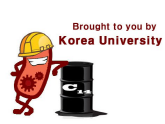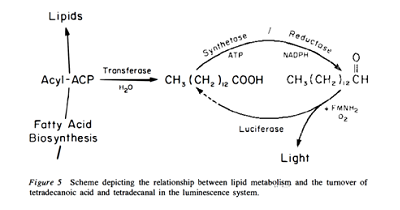Team:Korea U Seoul/Project
From 2011.igem.org
| You can write a background of your team here. Give us a background of your team, the members, etc. Or tell us more about something of your choosing. | |
|
Tell us more about your project. Give us background. Use this is the abstract of your project. Be descriptive but concise (1-2 paragraphs) | File:Korea U Seoul team.png Your team picture |
| Team Example |
| Home | Team | Official Team Profile | Project | Parts Submitted to the Registry | Modeling | Notebook | Safety | Attributions |
|---|
Contents |
Overall project
The goal of our project is to produce alkane chains from glucose molecules. In nature, numerous biochemical pathways and enzymes exist, making life adoptable to even extreme conditions such as volcanic regions. We focused on biochemical pathways, enzymes of glucose metabolism and luminescene luciferase from Vibrio harveyi to achieve our goal. Based on glycolysis, pyruvate oxidation, enzymes coded in luciferase genes (lux operon) and FAC from cyanobacteria, glucose is turned into alkane chain of about 14 carbon atoms in length. Synthesized fuel is functionally identical to natural petroleum and can be used as bioenergy. Produced alkane chain is part of a carbon circulation cycle as it is synthesized from glucose, in vivo. The fuel is relatively environment-friendly, unlike ordinary petroleum which increases CO2 concentration in the atmosphere. Though the production of alkanes using bioblock could be not satisfied commercially, succeeding in the synthesis of alkane chains from glucose nevertheless will show another method of producing alternative energy source. Therefore, the success of this research will contribute to global effort in reducing atmospheric CO2 levels.
Project Abstract
Synthesis of Synthetic Micro-Alkanes (“Synfuels”) in Engineered Escherichia coli
Our team concentrated on finding the solution to the world’s diminishing natural oil and gas resources and greenhouse gas emissions. The aim of our project is the production of biofuels, alkanes, using bacterial cells as factories. Alkanes, so called “Green” hydrocarbon fuels, are chemically energetically the same as petroleum-based fuels, thus no penalty for use of conventional engines is encountered from their use. For alkane biosynthesis, we designed a synthetic circuit using bacterial bioluminescence system and aldehyde decarbonylase from Vibrio harveyi and cyanobacteria, respectively. Free fatty acids in the cells firstly are reduced and converted to fatty aldehydes by LuxC, LuxD and LuxE and then fatty aldehydes finally are decarbonylated and turned into alkanes.
Project Details
We believed that there exists difficulty in producing Wax ester. Therefore, we read carefully several dissertations in order to find a compound that we can use as biofuel. One of our members came up with an idea after finding a picture(shown below) about a synthetic pathway in fluorescing bacteria.
According to the picture above, it is possible to turn Acyl-ACP into a C14 aldehyde. We can then deduce from such a result the possibility of producing a C14 alkane from glucose, utilizing microorganisms as a synthetic machinery.
By considering such possibilities, team members began searching for pathways that utilize two substances, which are: 1. luxAB removed luxCDE from fluorescing bacteria 2. cyanobacteria's aldehyde decarbonylase gene
Picture below depicts biofuel synthetic pathway.
This is what we came up with. It is a pathway that utilizes luminescence system and fatty acid reduction pathway already present within E.coli. However, if a beta oxidation pathway is activated through acyl-CoA ligase, we will not be able to use carboxylic acid in the desired way. Therefore, we must use fadD to block beta oxidation.
Based on these results, we carefully set up our research plan.
According to the plan above, we performed pre-research until July 22nd. By pre-research, we mean studying about luminescence system and lux operon activation in E.coli by reading dissertations, and also studying about biosynthetic pathways of alkanes. We also searched for the potential uses of C14. The potential uses we found are uses as energy source for various transportation. Fuel used today is usually extracted from the bottom of the oceans or miles below earth's surface. While natural petroleum increases atmospheric CO2 levels causing environmental problems, biofuel is synthesized by incorporating carbon from CO2, making it more environmentally friendly. Lastly, we searched for methods that can be used detect fatty acid, fatty aldehyde, and hydrocarbon, which are all intermediates in the pathway. Unfortunately, we were not able to find a method that is efficient.
In order to prepare a proper medium, we searched for necessary nutrients in KACC(http://www.genebank.go.kr/) and KCTC(http://brc.re.kr/main.aspx). We then ordered and cultured Vibrio harveyi and cyanobacteria, followed by DNA extraction. After DNA extraction, we amplified target genes with PCR and as shown by the picture below, we made a circuit. Since luxCDE is a system not present in E.coli, we must clone, insert it into E.coli's gene. After initial experiment, luminescence did not occur. We are re-examining the processes.
Synthetic Fatty Acids Reduction Pathway
Cloning of target genes
Results
- Vibrio harveyi KACC 14795 was cultivated in Marine broth 2216 at 26ºC.
- Vibrio harveyi genomic DNA extraction gave the following results.
- Cloning of luxCDABE to T7 promoter system by Ligation Independent Cloning gave the following results.
- Expression tests were done on luxCDABE.
- - Induction : OD600(~0.8), 0.5mM IPTG, 37ºC, LB medium
- - LuxC (54.8kDa), LuxD (34.2kDa), LuxA (40kDa), LuxB (36.3kDa), LuxE (42.9kDa)
 "
"







